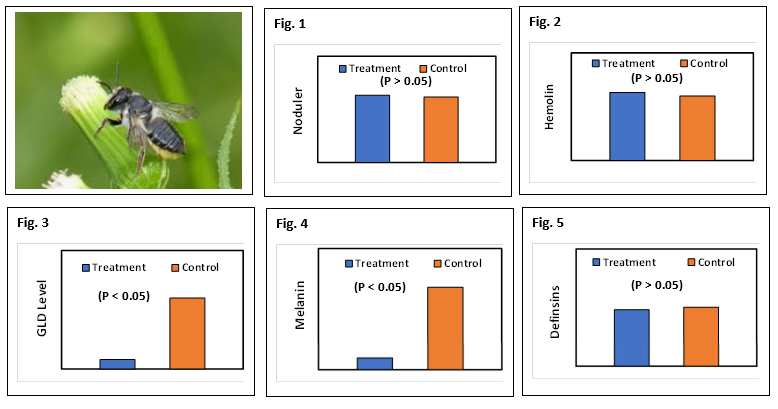After graduating from UNC Charlotte with the BS in Biology, you are hired as a technician in a U. S. Department of Agriculture Research Station and assigned to a team that is investigating a new malady that has appeared in leaf cutter bees (shown below). Leaf cutter bees are solitary (i.e. non-social) bees which are essential pollinators for many of the crops that we feed livestock, such as alfalfa. The bees are becoming infected with a gram-positive bacteria that alters their immune response such that the bacteria cannot be eliminated and eventually the bees die. Your team is investigating how the bacteria might alter the bees’ immune response. You set up two groups of leaf cutter bees: the Treatment group is infected with the bacteria and the Control group is uninfected. You then compare the two groups for the different components of the insect immune system shown in the figures below (in Fig. 3 GLD = FAD-glucose dehydrogenase). Remember: P > 0.05 means the differences are not significant; P < 0.05 means the differences are significant. True and False: 1. The results indicate that the bacteria are interfering with the ability of plasmatocytes to carry out the process of nodulation. 2. The results indicate that the functioning of granulocytes is unaffected. 3. The bacteria are blocking the formation of pattern recognition receptors by hemocytes and cells of the fat bodies, thereby preventing an immune response from being initiated
After graduating from UNC Charlotte with the BS in Biology, you are hired as a technician in a U. S. Department of Agriculture Research Station and assigned to a team that is investigating a new malady that has appeared in leaf cutter bees (shown below). Leaf cutter bees are solitary (i.e. non-social) bees which are essential pollinators for many of the crops that we feed livestock, such as alfalfa. The bees are becoming infected with a gram-positive bacteria that alters their immune response such that the bacteria cannot be eliminated and eventually the bees die. Your team is investigating how the bacteria might alter the bees’ immune response. You set up two groups of leaf cutter bees: the Treatment group is infected with the bacteria and the Control group is uninfected. You then compare the two groups for the different components of the insect immune system shown in the figures below (in Fig. 3 GLD = FAD-glucose dehydrogenase). Remember: P > 0.05 means the differences are not significant; P < 0.05 means the differences are significant.
True and False:
1. The results indicate that the bacteria are interfering with the ability of plasmatocytes to carry out the process of nodulation.
2. The results indicate that the functioning of granulocytes is unaffected.
3. The bacteria are blocking the formation of pattern recognition receptors by hemocytes and cells of the fat bodies, thereby preventing an immune response from being initiated.

Step by step
Solved in 2 steps







